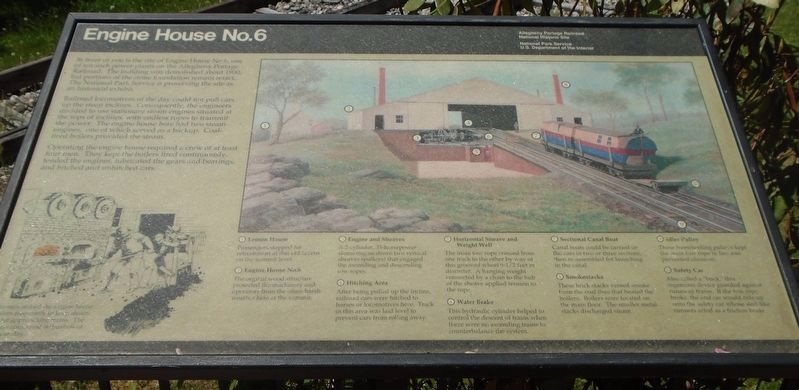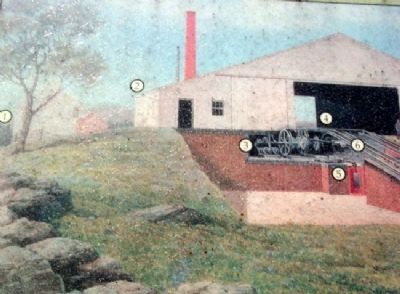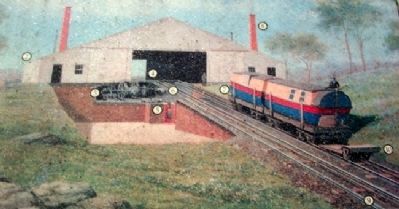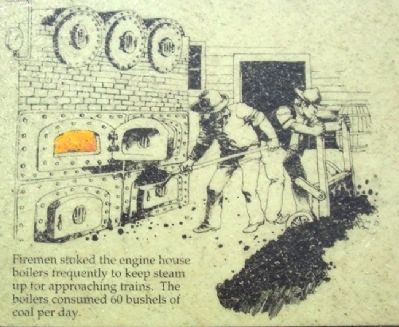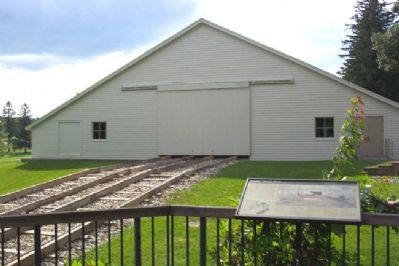Allegheny Portage Railroad National Historic Site in Cambria County, Pennsylvania — The American Northeast (Mid-Atlantic)
Engine House No. 6
In front of you is the site of Engine House No. 6, one of ten such power plants on the Allegheny Portage Railroad. The building was demolished in 1900, but portions of the stone foundation remain intact. The National Park Service is preserving the site as an historical exhibit.
Railroad locomotives of the day could not pull cars up the steep inclines. Consequently, the engineers decided to use stationary steam engines situated at the tops of inclines, with endless ropes to transmit the power. The engine house here had two steam engines, one of which served as a backup. Coal-fired boilers provided the steam.
Operating the engine house required a crew of at least four men. They kept the boilers fired continuously, tended the engines, lubricated the gears and bearings, and hitched and unhitched cars.
[Boiler drawing caption reads]
Firemen stoked the engine house boilers frequently to keep steam up for approaching trains. The boilers consumed 60 bushels of coal per day.
[Engine House No. 6 operational drawing caption reads]
1. Lemon House
Passengers stopped for refreshment at this old tavern on the summit level.
2. Engine House No. 6
The original wood structure protected the machinery and operators from the often-harsh weather here at the summit.
3. Engine and Sheaves
A 2-cylinder, 35-horsepower steam engine drove two vertical sheaves (pulleys) that engaged the ascending and descending tow ropes.
4. Hitching Area
After being pulled up the incline, railroad cars were hitched to horses or locomotives here. Track in this area was laid level to prevent cars from rolling away.
5. Horizontal Sheave and Weight Well
The main tow rope crossed from one track to the other by way of this grooved wheel 9-1/2 feet in diameter. A hanging weight connected by a chain to the hub of the sheave applied tension to the rope.
6. Water Brake
This hydraulic cylinder helped to control the descent of trains when there were no ascending trains to counterbalance the system.
7. Sectional Canal Boat
Canal boats could be carried on flat cars in two or three sections, then re-assembled for launching in the canal.
8. Smokestacks
These brick stacks vented smoke from the coal fires that heated the boilers. Boilers were located on the main floor. The smaller metal stacks discharged steam.
9. Idler Pulley
These freewheeling pulleys kept the main tow rope in line and prevented abrasion.
10. Safety Car
Also called a "buck," this ingenious device guarded against runaway trains. If the tow rope broke, the end car would ride up onto the safety car whose sled-like runners acted as a friction brake.
Erected by National Park Service.
Topics. This historical marker is listed in these topic lists: Industry & Commerce • Man-Made Features • Railroads & Streetcars • Waterways & Vessels. A significant historical year for this entry is 1900.
Location. 40° 27.366′ N, 78° 33.008′ W. Marker is in Allegheny Portage Railroad National Historic Site, Pennsylvania, in Cambria County. Marker is along the trail leading from the Visitor Center to Engine House No. 6. Touch for map. Marker is at or near this postal address: 110 Federal Park Road, Gallitzin PA 16641, United States of America. Touch for directions.
Other nearby markers. At least 8 other markers are within walking distance of this marker. Allegheny Portage Railroad (here, next to this marker); Inclined Plane No. 6 (here, next to this marker); Skew Arch Bridge Trail (here, next to this marker); Railroad Stone (about 300 feet away, measured in a direct line); The Lemon House (about 400 feet away); Levels (about 400 feet away); Summit Level Historic Area (about 500 feet away); a different marker also named Lemon House (about 700 feet away). Touch for a list and map of all markers in Allegheny Portage Railroad National Historic Site.
Also see . . . Allegheny Portage Railroad National Historic Site. (Submitted on March 22, 2012, by William Fischer, Jr. of Scranton, Pennsylvania.)
Credits. This page was last revised on May 30, 2023. It was originally submitted on March 22, 2012, by William Fischer, Jr. of Scranton, Pennsylvania. This page has been viewed 616 times since then and 36 times this year. Photos: 1. submitted on May 30, 2023, by William Fischer, Jr. of Scranton, Pennsylvania. 2, 3, 4, 5. submitted on March 22, 2012, by William Fischer, Jr. of Scranton, Pennsylvania.
